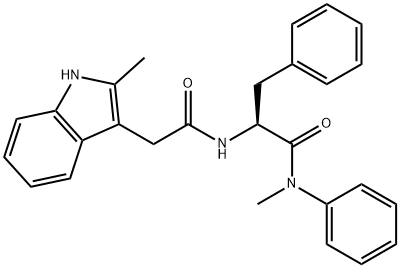PFI-2 (hydrochloride)
Synonym(s):(R)-8-Fluoro-N-(1-oxo-1-(pyrrolidin-1-yl)-3-(3-(trifluoromethyl)phenyl)propan-2-yl)-1,2,3,4-tetrahydroisoquinoline-6-sulfonamide hydrochloride
- CAS NO.:1627607-87-7
- Empirical Formula: C23H26ClF4N3O3S
- Molecular Weight: 535.98
- MDL number: MFCD28133380
- Update Date: 2024-11-19 20:33:22

What is PFI-2 (hydrochloride)?
Description
SET domain-
The Uses of PFI-2 (hydrochloride)
(1R)-1-[[3-(Trifluoromethyl)phenyl]methyl]-2-oxo-2-(1-pyrrolidinyl)ethyl]1,2,3,4-tetrahydro-6-isoquinolinesulfonamide Hydrochloride known as (-)-PFI-2 HCl is a cell permeable inhibitor of SET Domain-Containing protein 7/9 (SET 7/9) which plays a role in tumorigenesis in cell cancer lines.
Biochem/physiol Actions
(R)-PFI-2 is a histone-lysine N-methyltransferase (HKMT) inhibitor selective for SETD7 (also known as SET9). (R)-PFI-2 has an IC50 value of 2 nM and 1000-fold selectivity over other methyltransferases and other non-epigenetic targets. For full characterization details, please visit the PFI-2 probe summary on the Structural Genomics Consortium (SGC) website.(S)-PFI-2, an enantiomer of (R)-PFI-2, is used as a negative control. (S)-PFI-2 is available from Sigma. To learn more about and purchase (S)-PFI-2, click here.To learn about other SGC chemical probes for epigenetic targets, visit sigma.com/sgc
storage
Store at -20°C
References
1)?Barsyte-Lovejoy?et al.?(2014),?(R)-PFI-2 is a potent and selective inhibitor of SETD7 methyltransferase activity in cells;?Proc. Natl. Acad. Sci. USA?111?12853
Properties of PFI-2 (hydrochloride)
| Melting point: | >209°C (dec.) |
| storage temp. | 2-8°C |
| solubility | Soluble in DMSO (up to at least 25 mg/ml) |
| form | powder |
| color | white to beige |
| Stability: | Stable for 1 year from date of purchase as supplied. Solutions in DMSO may be stored at -20°C for up to 2 months. |
Safety information for PFI-2 (hydrochloride)
| Signal word | Warning |
| Pictogram(s) |
 Exclamation Mark Irritant GHS07 |
| GHS Hazard Statements |
H302:Acute toxicity,oral |
Computed Descriptors for PFI-2 (hydrochloride)
New Products
Tert-butyl bis(2-chloroethyl)carbamate 4-Methylphenylacetic acid N-Boc-D-alaninol N-BOC-D/L-ALANINOL N-octanoyl benzotriazole 3-Morpholino-1-(4-nitrophenyl)-5,6-dihydropyridin- 2(1H)-one Furan-2,5-Dicarboxylic Acid DIETHYL AMINOMALONATE HYDROCHLORIDE 1,1’-CARBONYLDIIMIDAZOLE R-2-BENZYLOXY PROPIONIC ACID 1,1’-CARBONYLDI (1,2-4 TRIAZOLE) N-METHYL INDAZOLE-3-CARBOXYLIC ACID (2-Hydroxyphenyl)acetonitrile 4-Bromopyrazole 5-BROMO-2CYANO PYRIDINE 5,6-Dimethoxyindanone 5-broMo-2-chloro-N-cyclopentylpyriMidin-4-aMine 2-(Cyanocyclohexyl)acetic acid 4-methoxy-3,5-dinitropyridine 1-(4-(aminomethyl)benzyl)urea hydrochloride 2-aminopropyl benzoate hydrochloride diethyl 2-(2-((tertbutoxycarbonyl)amino) ethyl)malonate tert-butyl 4- (ureidomethyl)benzylcarbamate Ethyl-2-chloro((4-methoxyphenyl)hydrazono)acetateRelated products of tetrahydrofuran



![4-[3-Oxo-3-(2-oxo-2,3-dihydrobenzoxazol-6-yl)propyl]piperazine-1-carboxylic acid 3,5-dichlorobenzyl ester](https://img.chemicalbook.in/CAS/GIF/1144035-53-9.gif)




You may like
-
 (R)-PFI-2 CAS 1627607-87-7View Details
(R)-PFI-2 CAS 1627607-87-7View Details
1627607-87-7 -
 1975-50-4 98%View Details
1975-50-4 98%View Details
1975-50-4 -
 2-HYDROXY BENZYL ALCOHOL 98%View Details
2-HYDROXY BENZYL ALCOHOL 98%View Details
90-01-7 -
 2-Chloro-1,3-Bis(Dimethylamino)Trimethinium Hexafluorophosphate 221615-75-4 98%View Details
2-Chloro-1,3-Bis(Dimethylamino)Trimethinium Hexafluorophosphate 221615-75-4 98%View Details
221615-75-4 -
 61397-56-6 CIS BROMO BENZOATE 98%View Details
61397-56-6 CIS BROMO BENZOATE 98%View Details
61397-56-6 -
 14714-50-2 (2-Hydroxyphenyl)acetonitrile 98+View Details
14714-50-2 (2-Hydroxyphenyl)acetonitrile 98+View Details
14714-50-2 -
 118753-70-1 98+View Details
118753-70-1 98+View Details
118753-70-1 -
 733039-20-8 5-broMo-2-chloro-N-cyclopentylpyriMidin-4-aMine 98+View Details
733039-20-8 5-broMo-2-chloro-N-cyclopentylpyriMidin-4-aMine 98+View Details
733039-20-8